4, Experimental conclusion
1. Experimental task 1
- Program task1.asm source code
1 assume cs:code, ds:data 2 3 data segment 4 x db 1, 9, 3 5 len1 equ $ - x ; Symbolic constants, $Refers to the offset address of the next data item. In this example, it is 3 6 7 y dw 1, 9, 3 8 len2 equ $ - y ; Symbolic constants, $Refers to the offset address of the next data item. In this example, it is 9 9 data ends 10 11 code segment 12 start: 13 mov ax, data 14 mov ds, ax 15 16 mov si, offset x ; Take symbol x Corresponding offset address 0 -> si 17 mov cx, len1 ; From symbol x Number of consecutive byte data items at the beginning -> cx 18 mov ah, 2 19 s1:mov dl, [si] 20 or dl, 30h 21 int 21h 22 23 mov dl, ' ' 24 int 21h ; Output space 25 26 inc si 27 loop s1 28 29 mov ah, 2 30 mov dl, 0ah 31 int 21h ; Line feed 32 33 mov si, offset y ; Take symbol y Corresponding offset address 3 -> si 34 mov cx, len2/2 ; From symbol y Number of consecutive word data items started -> cx 35 mov ah, 2 36 s2:mov dx, [si] 37 or dl, 30h 38 int 21h 39 40 mov dl, ' ' 41 int 21h ; Output space 42 43 add si, 2 44 loop s2 45 46 mov ah, 4ch 47 int 21h 48 code ends 49 end start
Operation screenshot:
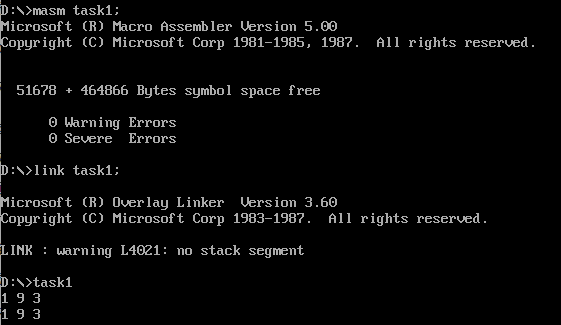
- Answer question ①
When reading the assembly instruction loop s1, the IP points to 001B, and after executing the instruction, the IP points to 000D. The jump displacement is - 14. F2 in the machine code E2F2 corresponding to the instruction is the hexadecimal complement of jump displacement - 14. The CPU adds the jump displacement to the IP value to obtain the IP of the next instruction to be executed, that is, 000D.
- Answer question ②
When reading the assembly instruction loop s2, the IP points to 0039, and after executing the instruction, the IP points to 0029. The jump displacement is - 16. F0 in the machine code E2F0 corresponding to the instruction is the hexadecimal complement of jump displacement - 16. The CPU adds the jump displacement to the IP value to obtain the IP of the next instruction to be executed, i.e. 0029.
- Question ③
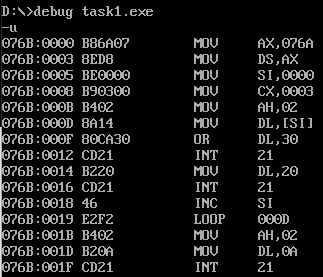
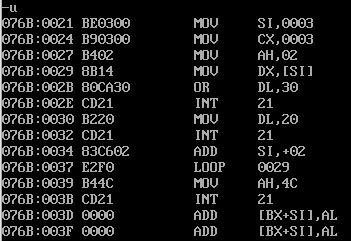
2. Experimental task 2
- Program task2.asm source code
1 assume cs:code, ds:data 2 3 data segment 4 dw 200h, 0h, 230h, 0h 5 data ends 6 7 stack segment 8 db 16 dup(0) 9 stack ends 10 11 code segment 12 start: 13 mov ax, data 14 mov ds, ax 15 16 mov word ptr ds:[0], offset s1 17 mov word ptr ds:[2], offset s2 18 mov ds:[4], cs 19 20 mov ax, stack 21 mov ss, ax 22 mov sp, 16 23 24 call word ptr ds:[0] 25 s1: pop ax 26 27 call dword ptr ds:[2] 28 s2: pop bx 29 pop cx 30 31 mov ah, 4ch 32 int 21h 33 code ends 34 end start
- ① When the CPU executes the call instruction, it will stack the current IP (or CS and IP). Therefore, the IP corresponding to the line25 (pop ax) instruction should be stored in ax, the IP corresponding to the line28 (pop bx) instruction should be stored in bx, and the CS corresponding to the line28 instruction should be stored in cx.
As can be seen from the figure below, register (ax)=0021, (bx)=0026, (cx)=076C
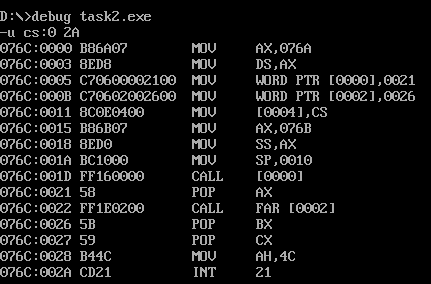
② Screenshot of debugging result interface:

The debugging results are consistent with the theoretical analysis results.
3. Experimental task 3
- Program source code task3.asm
1 assume cs:code, ds:data 2 3 data segment 4 x db 99, 72, 85, 63, 89, 97, 55 5 len equ $- x 6 data ends 7 8 code segment 9 start: 10 mov ax, data 11 mov ds, ax 12 13 mov cx, len ;From symbol x Number of consecutive byte data items at the beginning 14 mov si, 0 15 s: 16 mov ah, 0 17 mov al, ds:[si] ;A two digit number occupies one byte 18 call printNumber 19 call printSpace 20 inc si 21 loop s 22 23 mov ah, 4ch 24 int 21h 25 26 ;Outputs a two digit number in decimal form 27 printNumber: 28 mov bl, 10 29 div bl 30 mov dl, al ;Quotient: ten digits 31 mov dh, ah ;Remainder: single digit 32 or dl, 30h ;Convert numbers to corresponding characters 33 or dh, 30h 34 35 mov ah, 2 36 int 21h 37 mov dl, dh 38 int 21h 39 ret 40 41 ;Print a space 42 printSpace: 43 mov ah, 2 44 mov dl, ' ' 45 int 21h 46 ret 47 48 code ends 49 end start
- Screenshot of running test

4. Experimental task 4
As can be seen from the figure below,
Green words on black background: 0000 0010, converted to hexadecimal to 2H
Red letter on black background: 0000 0100, converted to hexadecimal 4H

- Program source code task4.asm
1 assume cs:code, ds:data 2 3 data segment 4 str db 'try' 5 len equ $ - str 6 data ends 7 8 code segment 9 start: 10 mov ax, data 11 mov ds, ax 12 mov ax, 0b800h 13 mov es, ax 14 15 mov si, offset str 16 mov bl, 2h ;String color 17 mov bh, 0 ;Specify row 18 call printStr 19 20 mov si, offset str 21 mov bl, 4h 22 mov bh, 24 23 call printStr 24 25 mov ah, 4ch 26 int 21h 27 28 ;Displays the string on the screen in the specified line and in the specified color 29 printStr: 30 ;Calculate the first offset address corresponding to the line number 31 mov al, bh 32 mov dl, 00A0h 33 mul dl 34 35 mov di, ax 36 mov cx, len ;From symbol str Number of consecutive byte data items at the beginning 37 s: 38 mov al, ds:[si] 39 mov es:[di], al 40 inc di 41 mov es:[di], bl 42 inc si 43 inc di 44 loop s 45 ret 46 47 code ends 48 end start
- Screenshot of running test
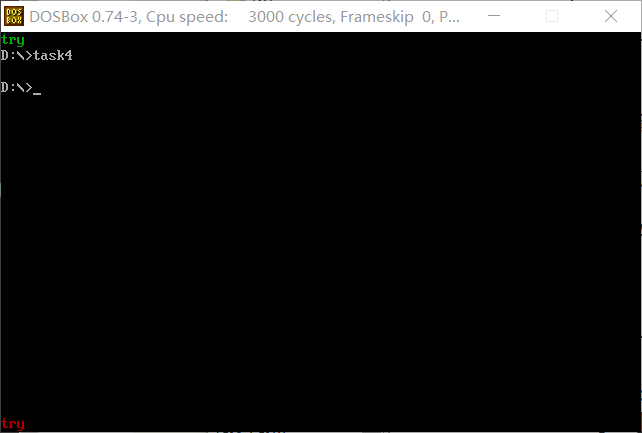
5. Experimental task 5
White words on blue background: 0001 0111, converted to hexadecimal 17H
Column 80, '-' 34 student number 12 '-' 34
- Program source code task5.asm
1 assume cs:code, ds:data 2 3 data segment 4 stu_no db '201983290259' 5 len = $ - stu_no 6 data ends 7 8 code segment 9 start: 10 mov ax, data 11 mov ds, ax 12 mov ax, 0b800h 13 mov es, ax 14 15 mov si, offset stu_no 16 mov di, 0 17 mov bl, 17h ;White characters on blue background 18 call printColor 19 call printLine 20 call printNumber 21 call printLine 22 23 mov ah, 4ch 24 int 21h 25 ;Print background color 26 printColor: 27 mov cx, 1920 ;First 24 lines 24*80 28 s0: 29 inc di 30 mov es:[di],bl 31 inc di 32 loop s0 33 ret 34 35 ;Print student number 36 printNumber: 37 mov cx, len ;From symbol stu_no Number of consecutive byte data items at the beginning 38 s1: 39 mov al, ds:[si] 40 mov es:[di], al 41 inc di 42 mov es:[di], bl 43 inc si 44 inc di 45 loop s1 46 ret 47 48 ;Print 34'-' 49 printLine: 50 mov cx, 34 51 s2: 52 mov word ptr es:[di], '-' 53 inc di 54 mov es:[di], bl 55 inc di 56 loop s2 57 ret 58 59 code ends 60 end start
- Screenshot of running test
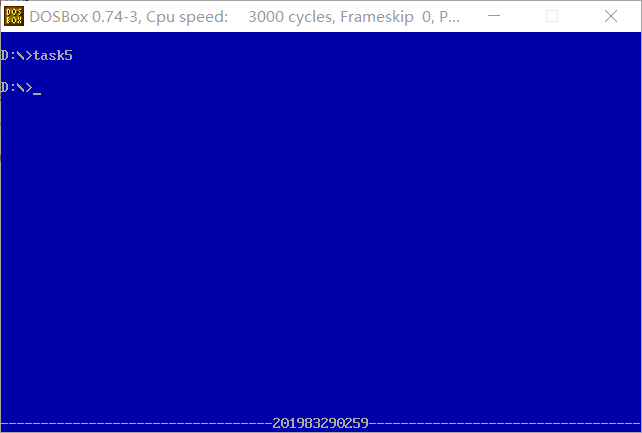
5, Experimental summary
The use of the operator offset is the offset label, which is used to take the offset address of the label during assembly.
The pseudo instruction equ is used for equivalent assignment, and its format is < symbol name > equ < expression >.
Predefined symbol $, equivalent to the current offset value of the segment currently being assembled.